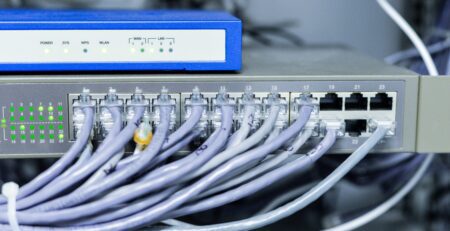Network Management with Smart Switches
Network management is an essential task to ensure that all of an organization's operations run efficiently and securely. In the modern environment, where connectivity is crucial, smart switches emerge as a powerful solution to optimize network management, especially in public institutions. This article will explore how smart switches can transform the way networks are managed, highlighting their benefits, practical applications, and how they can reduce operational costs.
What are Smart Switches?
Smart switches, also known as managed switches, are network devices that offer advanced management and configuration functionality. Unlike unmanaged switches, which simply connect devices on a network, smart switches allow network administrators to monitor, control, and optimize network traffic. They are equipped with features such as VLANs (Virtual Local Area Networks), QoS (Quality of Service), and SNMP (Simple Network Management Protocol) monitoring.
Benefits of Smart Switches
Using smart switches in a network offers numerous advantages. Firstly, they provide granular control over network traffic, allowing you to prioritize certain types of data, such as VoIP calls or streaming video. This ensures that critical applications receive the necessary bandwidth, improving overall network performance. Additionally, smart switches offer advanced security features, such as port-based access control, that help protect the network from unauthorized access.
Performance and Efficiency
One of the main advantages of smart switches is their ability to improve network performance and efficiency. With features such as load balancing and traffic prioritization, it is possible to ensure that the network operates optimally, avoiding congestion and ensuring an equitable distribution of bandwidth between all connected devices. This is especially important in high-demand environments, such as public institutions, where network stability and efficiency are crucial.
Security and Reliability
Security is a primary concern in any network, and smart switches offer several features that help keep the network secure. Features such as ACLs (Access Control Lists) allow you to define specific rules to control incoming and outgoing traffic, while 802.1X authentication support ensures that only authorized devices can connect to the network. Additionally, the ability to segment the network into VLANs helps isolate different types of traffic, further increasing security and reliability.
Ease of Management
Smart switches are designed to make network management easier. They offer intuitive user interfaces and centralized management tools that allow you to efficiently monitor and control your network. With support for protocols like SNMP, administrators can receive real-time alerts on network status, quickly identify and resolve issues, and adjust settings as needed to optimize performance.
Scalability and Flexibility
As network needs evolve, the ability to scale and adapt infrastructure is essential. Smart switches are highly scalable, allowing you to add new devices and segment the network as needed without major disruptions. This is particularly useful in public institutions that may have varying connectivity demands, such as schools and hospitals that need to quickly adapt to new technologies and capacity increases.
Use Cases in Public Institutions
Smart switches are especially valuable in public institutions. In schools, for example, they can help manage network traffic between classrooms, computer labs and administrative areas, ensuring that all users have stable and fast internet access. In hospitals, network segmentation through VLANs can isolate critical medical data traffic from administrative traffic, increasing security and reliability.
Configuration and Implementation
Implementing smart switches may seem like a complex task, but with the right approach, the process can be simplified. The first step is to plan the network, defining specific connectivity and segmentation needs. Switches are then configured to support these needs, using management tools to define VLANs, QoS and other functionality. Finally, the network is monitored and adjusted as needed to ensure it is operating optimally.
Monitoring and Maintenance
After implementation, continuous monitoring of the network is crucial to maintain its performance. Smart switches offer a variety of tools for real-time monitoring, allowing you to identify and resolve issues before they impact end users. Preventative maintenance, such as updating firmware and regularly reviewing configurations, is also essential to ensure your network remains secure and efficient.
Reduction of Operating Costs
One of the less obvious but extremely important advantages of smart switches is reduced operating costs. With the ability to manage your network more efficiently, you can reduce the time and resources needed to resolve issues and minimize downtime. The automation of management tasks and the use of advanced monitoring tools contribute to this cost reduction, making the IT infrastructure more economical in the long term.
Solutions to Common Problems
Even with a well-managed network, problems can arise. Smart switches make it easy to identify and resolve these issues by offering tools like detailed event logs and network diagnostics. This allows administrators to quickly identify the root cause of an issue and take the necessary corrective action to restore normal network operation.
Future of Smart Switches
The field of smart switches is constantly evolving, with new technologies and features being introduced regularly. Integration with artificial intelligence and machine learning solutions promises to take network management to a new level, with the ability to predict problems before they occur and automatically optimize network performance. These innovations will ensure that smart switches continue to be an essential part of any modern IT infrastructure.
Final considerations
In this article, we explore how smart switches can optimize network management in public institutions. From increasing performance and efficiency to improving security and reducing operational costs, smart switches offer a comprehensive solution to modern networking challenges.
Common questions
1. What are VLANs and how do they work in smart switches?
VLANs (Virtual Local Area Networks) allow you to segment the physical network into several logical networks, improving security and traffic management.
2. What are the main benefits of smart switches for public institutions?
They offer greater control, security, efficiency and scalability, essential for environments with high demand for connectivity.
3. How can smart switches reduce operational costs?
Through advanced management and monitoring tools, which reduce the time and resources required for maintenance and troubleshooting.
4. What is the difference between managed and unmanaged switches?
Managed switches offer advanced control and monitoring functionality, while unmanaged switches simply connect devices without management options.
5. What are the future trends for smart switches?
Integration with AI and machine learning to predict problems and automatically optimize network performance.
Conclusion
The use of smart switches is an effective strategy for optimizing network management in public institutions. With benefits ranging from improved performance to reduced costs, these devices are essential for any modern IT infrastructure. If you are interested in improving your institution's network, consider purchasing smart switching services from C2H Solutions. To receive a quote, simply get in touch via the contact page on the website.






Comments (14)
💡 Os switches inteligentes não apenas otimizam o tráfego de dados, mas também proporcionam uma gestão mais eficiente da rede, garantindo segurança e confiabilidade. Não perca a chance de potencializar sua infraestrutura!
👉 Quer aprofundar seus conhecimentos sobre #Switches Inteligentes? Explore mais conteúdos exclusivos em nosso blog na seção #Switches Inteligentes.
🤝 Envie um email para nosso departamento comercial! comercial@c2hsolutions.com.br
💡 A implementação de switches inteligentes pode transformar a eficiência da sua rede, proporcionando maior controle e segurança. Invista na tecnologia certa para otimizar sua infraestrutura!
👉 Quer aprofundar seus conhecimentos sobre #Switches Inteligentes? Explore mais conteúdos exclusivos em nosso blog na seção #Switches Inteligentes.
🤝 Envie um email para nosso departamento comercial! comercial@c2hsolutions.com.br
💡 Os switches inteligentes são ferramentas poderosas que podem otimizar sua rede e aumentar a segurança dos seus dados. Conheça as funcionalidades que podem transformar a sua infraestrutura!
👉 Quer aprofundar seus conhecimentos sobre #Switches Inteligentes? Explore mais conteúdos exclusivos em nosso blog na seção #Switches Inteligentes.
🤝 Envie um email para nosso departamento comercial! comercial@c2hsolutions.com.br
💡 A implementação de switches inteligentes pode transformar a eficiência da sua rede, proporcionando melhor gerenciamento e segurança. Quais são os desafios que você já enfrentou na sua infraestrutura? 👉 Quer aprofundar seus conhecimentos sobre #Switches Inteligentes? Explore mais conteúdos exclusivos em nosso blog na seção #Switches Inteligentes. 🤝 Envie um email para nosso departamento comercial! comercial@c2hsolutions.com.br
💡 Os switches inteligentes estão transformando o gerenciamento de redes, oferecendo eficiência e segurança como nunca antes! É essencial entender suas funcionalidades para otimizar sua infraestrutura.
👉 Quer aprofundar seus conhecimentos sobre #Switches Inteligentes? Explore mais conteúdos exclusivos em nosso blog na seção #Switches Inteligentes.
🤝 Envie um email para nosso departamento comercial! comercial@c2hsolutions.com.br
💡 A implementação de switches inteligentes pode transformar a gestão de redes, aumentando a eficiência e a segurança dos dados. Essa tecnologia é essencial para empresas que buscam inovação e confiabilidade em suas operações!
👉 Quer aprofundar seus conhecimentos sobre #Switches Inteligentes? Explore mais conteúdos exclusivos em nosso blog na seção #Switches Inteligentes.
🤝 Envie um email para nosso departamento comercial! comercial@c2hsolutions.com.br
💡 Os switches inteligentes são fundamentais para otimizar a performance e segurança da sua rede, permitindo uma gestão mais eficiente e confiável! Não perca a oportunidade de descobrir como eles podem transformar sua infraestrutura.
👉 Quer aprofundar seus conhecimentos sobre #Switches Inteligentes? Explore mais conteúdos exclusivos em nosso blog na seção #Switches Inteligentes.
🤝 Envie um email para nosso departamento comercial! comercial@c2hsolutions.com.br
🔍 Os switches inteligentes são essenciais para otimizar o desempenho das redes modernas, proporcionando maior controle e segurança! Com as ferramentas certas, é possível transformar sua infraestrutura e aproveitar ao máximo suas capacidades.
👉 Quer aprofundar seus conhecimentos sobre #Switches Inteligentes? Explore mais conteúdos exclusivos em nosso blog na seção #Switches Inteligentes.
🤝 Envie um email para nosso departamento comercial! comercial@c2hsolutions.com.br
#Switches InteligentesGerenciamento de Redes com Switches Inteligentes#Switches InteligentesSegurança com Inovação e Confiabilidade – C2H Solutions
#Switches InteligentesGerenciamento de Redes com Switches Inteligentes#Switches InteligentesSegurança com Inovação e Confiabilidade – C2H Solutions
#Switches InteligentesGerenciamento de Redes com Switches Inteligentes#Switches InteligentesSegurança com Inovação e Confiabilidade – C2H Solutions
#Switches InteligentesGerenciamento de Redes com Switches Inteligentes#Switches InteligentesSegurança com Inovação e Confiabilidade – C2H Solutions
#Switches InteligentesGerenciamento de Redes com Switches Inteligentes#Switches InteligentesSegurança com Inovação e Confiabilidade – C2H Solutions
#Switches InteligentesGerenciamento de Redes com Switches Inteligentes#Switches InteligentesSegurança com Inovação e Confiabilidade – C2H Solutions